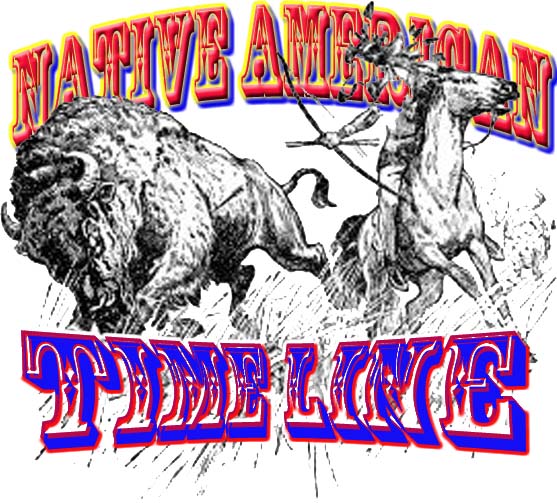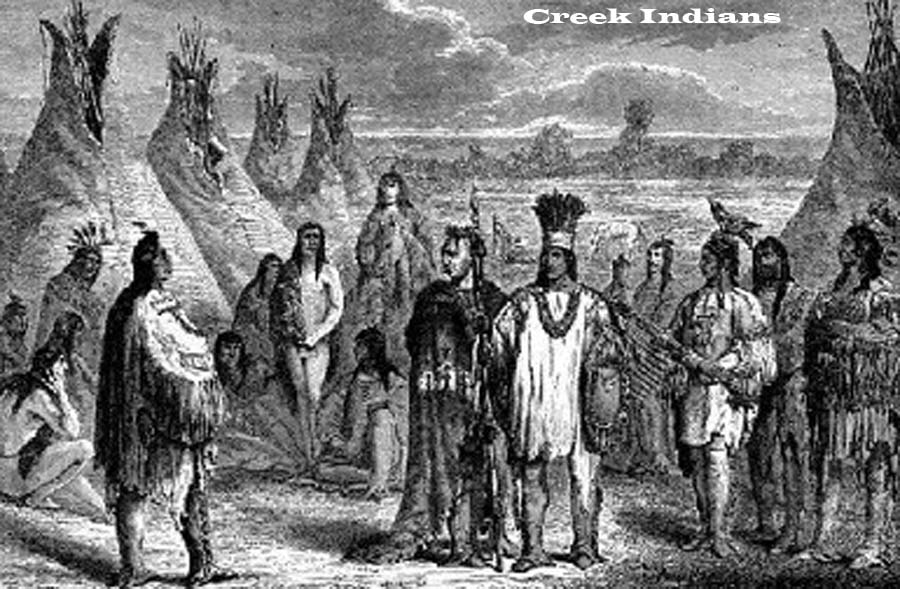1825
The Lower Towns Creek leader, William McIntosh, signed the Treaty of Indian Springs, surrendering much of their remaining homeland to the U.S. government, doing so he violated Creek law and the National Council ordered him and two other signatories to be executed for crimes against the Creek Nation.
1827
In Georgia, Creek Indians sigh another treaty surrendering there lands, and 703 Indians and 86 slaves began the migration towards Fort Gibson in Oklahoma.
1828
The first Indian newspaper is published in the Native American language by Elias Boudinot and Sequoyah.
1829
To gain better access to the water of the Tennessee River, in 1827-37, twenty-three thousand Creek Indians are removed from their native homeland and are relocated west of the Mississippi River.
1830
The Indian Removal Act was passed and thousand of Native Americans were forcibly removed from their homes, the Cherokee in Georgia could only hold council to sell land to whites, and the Choctaw were forced to sign a treaty that traded their rich homeland for land in Oklahoma.
1831
Black Hawk, the Chief of the Sauk, and the Fox tribes were pressured to sell their lands and mover west of the Mississippi River and stay there.
Georgia court rules that Indians, are neither US citizens, or an independent nation, but they are domestic dependents.
U.S. troops are beaten at Okeechobee by Black Seminole Indians in the Second Seminole War.
1831-32
The Supreme Court changes Indian tribal authority by ruling that they were domestic dependent nations and were a responsibility of the federal government.
1832
Red Clay, Tennessee, Eastern Cherokee refuse to discuss Presidents Jackson’s suggestions for their removal to Oklahoma Indian Territory unless the federal government honor what they promised in earlier treaties.
Illinois militia slaughter 150 Sac and Fox men, women, and children that were under a flag of truce at the Bad Axe River.
1833
Florida makes it against the law for Indians to be inside the boundaries of the state.
1834
Indian Territory is created in the west for those who were removed from their ancestral homelands, but by 1870 the land is decreased to the size of Oklahoma without the panhandle.
The Oglala Tribe organizes following Chief Bull Bear.
1835
Only a percentage of Cherokee Indians sign the Treaty of New Echota in which gives up their homelands and agree to move west to Indian Territory, the larger population did not agree to take these terms and refused to relocate.
1835-42
The U.S. government spent over 50 million dollars, more than the entire U.S. budget, for Indian removal in the second and most terrible of three Seminole Wars.
1836
The U.S. Army removes by force 14,000 Creek Indians from their Alabama homeland to Indian Territory in Oklahoma.
1837
Only two thousand out of six thousand Blackfoot survived the smallpox epidemic.
1838
The earlier treaties giving the Cherokee the right to stay on their lands was ignored by President Jackson when federal troops were used to forcibly remove 16,000 that refused to move west to Indian Territory under the Treaty of New Echota.
Indian people were driven by soldiers, like cattle, and were imprisoned without proper shelter where 1,500 died exposed the summer heat.
Because of harsh treatment and neglect on the forced march, over 4,000 Cherokee die on, “The Trail of Tears”, from their homeland to Indian Territory in Oklahoma.
Osceola, Chief of the Seminole Indians, who fought against the forced removal and relocation of his people to Indian Territory, dies of malaria at Fort Moultrie, South Carolina.
The invention of photography
1841
Forty-eight wagons arrive in Sacramento by way of the Oregon Trail, one of the earliest large groups to make this journey.
1843
Second Seminole War ends.
1847
Manifest Destiny, the 19-century belief that expansion of the U.S. was justified and inevitable, began westward through Indian lands on the Oregon Trail.
Thomas H. Hardy, Superintendent of Indian Affairs in St. Louis warns of trouble from declining buffalo herds.
1849
The American Fur Company sells Fort Laramie to the U.S. government and troops are stationed there.
All Indian affairs are moved to the new U.S. Department of the Interior.
The newly established Corps of Civilian workers offer medical care the Indians.
The first California Gold rush is started by James Marshall when he discovers gold in the stream at Sutter’s Mill and triggers the forty-niners seeking their fortune.
>>to return to previous page – right click on back arrow <<
Word count: 708







































